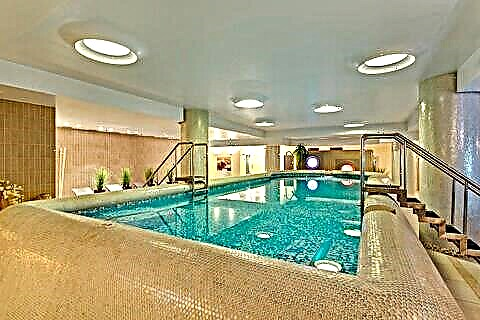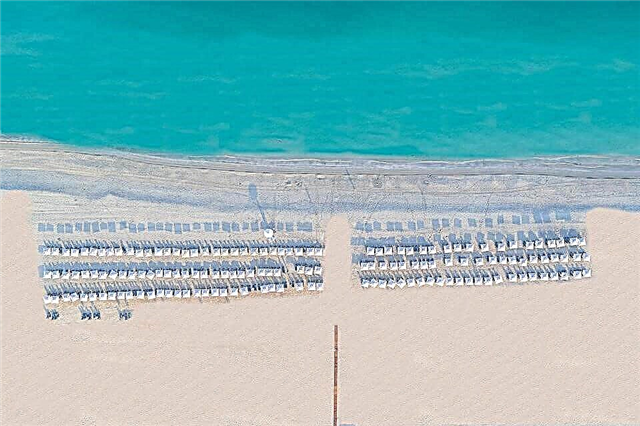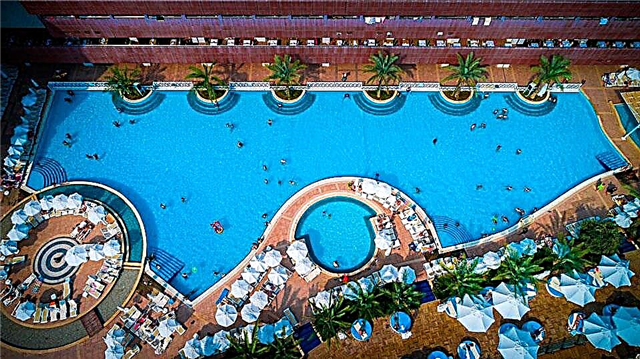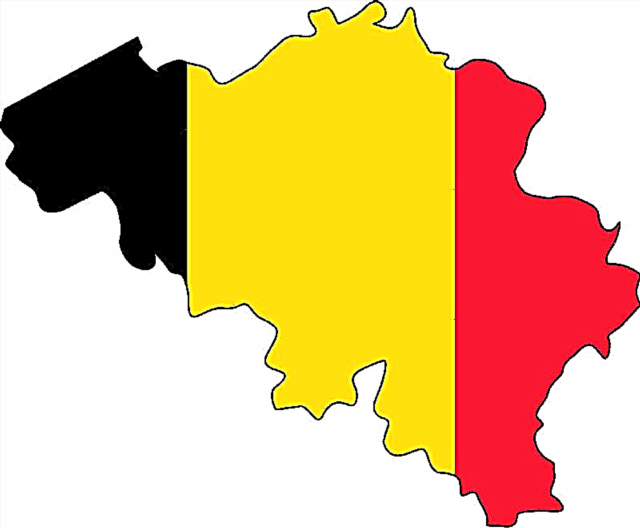On the picturesque hills above the mouth of the Douro River is the northern capital and pearl of Portugal - Porto. This granite, monumental and distinctive city attracts a considerable number of tourists with its special colorful atmosphere. Its historical center has received the status of a world cultural heritage from UNESCO. The abundance and variety of attractions is amazing. They can be found literally at every step. Cobbled winding streets and narrow quarters, picturesque embankments and park complexes, grandiose bridges and ancient buildings, medieval cathedrals and expressive architectural monuments - all this arouses genuine interest among travelers from all over the world. Tiled panels, luxurious interiors of temples and houses with colorful facades leave indelible impressions. What to see in Porto in 1 day on your own? The answer to this difficult question will allow you to correctly distribute precious time in order not to miss the significant places of the city.
Arrábida bridge

The Arrábida road and pedestrian bridge is one of six impressive structures that stretch over the beautiful Douro River. Its opening took place in 1963. Concrete pillars support one majestic arched span, which is 270 meters long. The object acts as a landmark and an important transport artery. There are four lanes for road traffic across the bridge.
As part of an excursion group, tourists will have the opportunity to make an exciting ascent along the steep steps of the arch of the Arrábida Bridge. There are 262 steps to be overcome. The staircase runs in an arc to a height of 65 meters above the water. The ascent and descent is considered a rather extreme event, therefore, expedition members are allowed only over 12 years old. The observation deck offers a magnificent panoramic view of the city and its surroundings from an extraordinary perspective.
Crystal Palace park

The landscape park of the Crystal Palace is always popular with guests and residents of the second largest Portuguese city. The picturesque place has the necessary attributes that allow visitors to enjoy a calm and measured walk. The territory of the park complex is decorated with winding paths, well-groomed green lawns, spreading trees, beautiful fountains, flower beds with strange flowers and crystal-clear ponds.
Of particular interest are the numerous old sculptural compositions and installations. A variety of allegorical monuments made in modern and antique styles will appear before the eyes of vacationers. Pines, camellias, beeches, rhododendrons and many other exotic plants create a romantic atmosphere. Peacocks imposingly walk along the neat paths. Benches are placed under the lush crowns of trees.
On the site of the former Crystal Palace, around which a park was laid out in 1851, a majestic multifunctional pavilion was erected. The structure is in terms of a huge hemispherical structure. It hosts cultural events, music concerts and sports events.
Cordoaria Park

Tourists should include a visit to the Cordoaria Park in the program of the day walk. It is located in the historic quarter not far from the main attractions of the city. The green square was founded on the territory where the workshop for the production of ropes and ropes was formerly located. In the middle of the 19th century, the small garden became a favorite resting place for the townspeople.
A distinctive feature of this cozy triangle-shaped garden is the century-old tall plane trees with dense foliage, spreading branches of an unusual shape. Fancy powerful thick trunks sharply taper upwards, which visually resemble giant bottles. Under the crowns of huge trees, you can hide from the scorching sun, and also enjoy the silence of a secluded corner.
A considerable number of sculptural compositions have been installed throughout the park, among which it is worth paying attention to an entertaining series of creations by the Spanish sculptor João Minos. Monuments are placed along the plane tree alley, which are stands of auditoriums with several figures of men with laughing faces.
Clerigos Tower

For many decades, the majestic Clérigos Tower has served as a significant and symbolic decoration of the city square. The six-story building in the late Baroque style was erected in the middle of the 18th century. The amazing structure rises 76 meters high. An architectural landmark is the bell tower of the church of the same name. For a long time, the tower served as a kind of landmark for merchant ships heading to the port harbor.
The magnificent historical site is richly decorated with granite slabs, cornices, sculptures, balustrades and relief carvings. The tall rectangular façade is crowned with a small dome with a Christian cross. The inner space of the building is occupied by a narrow spiral staircase leading to the observation deck. Climbing 225 steps, tourists will discover a delightful view of the architectural ensemble, tiled roofs of houses, neighborhoods, squares and the river bank.
Lello Bookstore

Porto is home to one of the most famous and original bookstores in the world - Livraria Lello. Its history dates back to the end of the 19th century. The historic building, built in the neo-Gothic style, is decorated with patterned ornaments, scalloped decorative elements and pinnacles. Its facade depicts the figures of two women, symbolizing the images of science and art.
The store is renowned for its amazingly luxurious interiors. Having crossed the threshold of the book boutique, visitors find themselves as if in the magical world of a fairy tale. The walls and vaults are abundantly lined with intricate openwork wood carvings. Noteworthy is the picturesque stained-glass ceiling, through which daylight of a golden hue passes. The interior features a curved staircase with bright red steps and elaborately carved railings. Tall bookcases that rise from floor to ceiling are crowned with curly arches. Here you can buy fiction and non-fiction by both Portuguese and foreign authors.
There is a cafe on the second floor. It is most convenient for visitors to enjoy the beauty of the decorative elements of the interior while drinking a cup of aromatic coffee. The store is always filled to the limit with curious people. Lello's bookstore gained immense popularity after the release of the first Harry Potter film. It was this place that inspired J.K. Rowling to create a fairy tale about young wizards. The writer lived for several years in Porto, where she taught English at one of the local schools. She was a frequent visitor to this store. <>
Porto Town Hall

The City Hall is deservedly one of the most photogenic architectural monuments of the northern capital. The monumental structure, made of granite and marble, harmoniously fits into the look of the central Freedom Square. The construction of the six-story building began in 1920 and stretched out over a quarter of a century. The created project has repeatedly undergone numerous changes by the chief architect K. Ramush.
On the main façade of the town hall, you can see numerous exquisite sculptures, intricate ornaments and coats of arms.Atlantes and Caryatids seem to support the architectural elements of the building. The statues represent the main activities for which the people of Portugal have been famous from time immemorial: navigation, winemaking, industry and various crafts. Columns, arches, as well as rectangular, oval and round window openings give the building a solemn appearance.
The town hall is crowned with a high tower with chimes. The interior design features several luxurious halls for city meetings and ceremonial events. Curious tourists can only get acquainted with the main hall, which attracts attention with its ceiling paintings.
Sao Bento train station

In the very center of the "northern capital" of Portugal is the São Bento train station. The historic building with a mansard roof and richly decorated stone façade is rightfully considered one of the expressive landmarks of the city. The first stone of the future station building was laid at the end of the 19th century on the site of the dilapidated and abandoned monastery of São Bento de Ave Maria. A grandiose architectural masterpiece in the French neoclassical style, it receives most of the commuter trains and electric trains.
Behind the entrance doors of the building, there is a magnificent interior decoration, which bewitches many tourists. The walls of the lobby are tiled with the famous Portuguese azulejos. Original ceramic tiles create picturesque paintings in a blue and white palette that depict the most important historical episodes of the development of Portugal, the country's landscapes, battle scenes, the exploits of kings, seafarers and knights, as well as the life of peasants and artisans. High stucco ceilings, marble floors and large stained-glass windows perfectly complement the ambience of the room.
Bishops palace

One of the oldest architectural monuments in Porto is the Bishop's Palace. Its construction was carried out in the XII-XIII centuries. During its long history, the residence of the Portuguese clergy has been rebuilt and expanded several times. The palace acquired its present appearance as a result of a large-scale reconstruction carried out in the 18th century. Currently, the building belongs to the state and is not used as a residence.
The palace is a rectangle in plan, forming an inner courtyard. The snow-white façade is adorned with three rows of curved window frames, oval borders and wrought iron French balconies. The central arched portal is made of dark granite. The lobby stands out in the interiors of the palace. The walls and ceiling are decorated with stucco, medallions and frescoes. Daylight enters through the glass dome.
The monumental front staircase with decorative railings and statues divides into two flights that lead to the state rooms. The premises display collections of antique carved furniture, rare ceramic decorations, tapestries from Flanders, silver and bronze dishes. Of interest is the gallery of paintings, as well as the Throne Room, where the inauguration of bishops took place.
Se Cathedral

At the top of the Pena Ventosa hill rises an iconic religious building and a national treasure throughout Portugal - the Se Cathedral. The temple looks like a fortress with massive inaccessible battlements and loopholes. The masterpiece of the Romanesque style of architecture was erected in the XII century. In this shrine, Portuguese kings were married, and Prince Heinrich the Navigator, a famous organizer and sponsor of sea expeditions, was also baptized.
On both sides of the central lead-gray façade, square towers topped with domes and balustrades rise upward. Above the baroque portal there is a round rose window, divided by a figured binding in the form of a flower. An extended covered gallery is attached to the northern part of the cathedral, the inner walls of which are faced with azulejo tiles. Ceramic tiles make up picturesque panels depicting scenes from the life of the Virgin Mary.
The interior of the temple is distinguished by its modest decoration. The gloomy surroundings correspond to the Medieval era. Visitors can see high vaulted ceilings, monumental gray columns, statues of saints and paintings in gilded frames. Noteworthy is the altar, the production of which took 800 kg of silver.
Bairro da Se

After inspecting and visiting the Se Cathedral, tourists can take a walk through the distinctive and picturesque quarter of Bairro da Se. A labyrinth of narrow streets stretches right below the majestic temple. On steep slopes among cozy and intricately intricate alleys, there are low houses, closely pressed together. It is home to the indigenous people of Porto.
The stairs resemble walkways. Linen is hung everywhere, children are frolicking around carelessly, roosters are singing in some places, the inviting cries of fishmongers are heard, artisans are knocking with their hammers. There is a feeling that the inhabitants of the area never leave their homes.
Ribeira

On a high, steep rocky slope along the Douro River, there is an interesting quarter of Ribeira. It is included in the UNESCO cultural heritage list, which attracts numerous travelers from all over the world. A leisurely stroll through Ribeira will allow travelers to feel the distinctive atmosphere of the city's oldest streets. The area is famous for the abundance of houses with picturesque multi-colored facades. They are literally stuck to each other and climb up the hill. The narrow cobbled streets are full of buildings, colorfully decorated with azulejo ceramic tiles, and some of the houses have foundations of ancient Roman stones. It is literally an open-air museum of Portuguese culture.
It is impossible to pass by the embankment of the quarter, along which cozy cafes, taverns and eateries stretch. Among the attractions of Ribeira, one should highlight the sculpture of John the Baptist and the fountain in the form of a huge bronze cube.
Prince's house

It is customary to call the house of the prince the historical building where the heir to the royal throne, Infante Henry, was born. His name is inextricably linked with the organization and financing of sea expeditions. The ancient building, dating back to the 14th century, was the only mansion where the royal family could stay during their official visits to Porto. Throughout its history, the building has managed to visit a customs office, a mint and a haven for workers. The building's modern appearance is the result of a global restoration work carried out in 1677.
The three-story Prince's House houses a museum filled with unique artifacts. Ceramic tiles, Roman mosaics, dioramas of the medieval city, coins, various goods, examples of pottery and many other exhibits are on display.
Church of St. Francis

In the historic center of the city, there is one of the most beautiful architectural masterpieces of Portugal - the Church of St. Francis. The construction of the temple dates back to 1233. Due to numerous disagreements between religious leaders, the construction of the shrine was delayed until 1425. The austere gray stone facade of the building is decorated in a Gothic style with baroque elements. The main dominant of the exterior is the huge rose window. The western portal is framed by ornate pillars and decorated with a granite statue of St. Francis. The southern gate is decorated with a pointed arch with archivolts and a triangular pediment with a pentagram.
The rather modest appearance of the church gave way to a dazzling luxury of interior decoration. Vaulted ceilings, walls, altars, pillars, arches and fences are lavishly clad with elaborate woodwork covered with gold leaf.Patterned and intricate carved details are represented by ornaments in the form of flowers, bunches of grapes, angels, animals and birds. The pearl of the church is the family tree of Jesus Christ, made of multi-colored wood. The sculptural composition consists of twelve figures of the kings of the Jews. A group of statues located on the branches of a tree is crowned by the Madonna and Child.
Fortress Fernandine

The medieval fortress, named after King Fernandin of Portugal, was a grandiose defensive structure. The fortification structure consisted of 30 towers and served to protect the city from external raids of enemies and conquerors. The mighty high walls of stone and granite were over 3,000 meters long. In the 18th century, the fortress lost its most important defensive function and fell into disrepair.
To this day, fragments of walls with jagged ends and loopholes have survived. A fairly long section of the medieval building runs along the hillside to the Douro River. The cable car line is nearby. Tourists can find the entrance to the inner side of the wall, which is hidden in the courtyard in the middle of a wonderful garden with orange trees. From the height of the fortress tower there is an amazing panoramic view of both banks of the river and the famous bridge named after Luis I.
Stock exchange palace

The Stock Exchange Palace is included in the list of architectural monuments that are recommended to be explored and visited by inquisitive guests of Porto. This beautiful monumental neoclassical building was erected in the 19th century. The palace was attended by representatives of the trade elite of Portugal and foreign countries. It became a kind of business center of the country, where economic decisions were made and commercial negotiations took place.
The imposing symmetrical rectangular building is adorned with a massive portico with a pediment, a clock tower and a three-arch portal. The external appearance of the palace is not able to convey even a fraction of the luxury that reigns in its interiors. Noteworthy is the inner Courtyard of Nations, crowned with an octagonal glass dome with metal panels, on its vaults you can see the images of the coats of arms of various countries with which Portugal maintained commercial relations.
A monumental marble staircase leads visitors to the halls, which amaze spectators with the pomp of the interior decoration. Of interest are old paintings, graceful sculptures, stained glass, decorative elements made of wood, stucco moldings, columns, fluted pilasters, floral ornaments, mosaics, ceiling frescoes and carved antique furniture. Tourists can enjoy the beauty of the halls of the palace as part of an excursion group.
Promenade Cais da Ribeira

The magnificent and vibrant promenade of Cais da Ribeira enchants travelers at first sight. It stretches along the southern bank of the Douro River. The popular and lively tourist destination consists of narrow streets and alleys lined with houses with colorful facades. Many historic buildings are tiled with azulejo ceramic tiles. Taverns, cafes and restaurants with cozy terraces offer visitors a taste of traditional Portuguese seafood.
Old boats and small ships are moored at the pier. Several centuries ago, they served to transport port wine from nearby villages to the city. Today, on these ships, tourists can go on an exciting river trip to admire the bridges and admire the color palette of the buildings.
Funicular

The Porto funicular is one of the most attractive means of transportation for travelers. It is an electric lift that connects the upper and lower parts of the city. The original road line was laid at the end of the 19th century. After several years of service, an accident occurred, after which the funicular ceased to function. Its restoration took place only in 2004.
A modern elevator equipped with an automatic mechanism plays an important transport role. It connects the Ribeira promenade with the Batalha area. The difference in height between the multi-tiered neighborhoods reaches 60 meters. If the pedestrian descent along the winding steep stairs will bring pleasure to vacationers, then the return trip may not cause such impressions. Therefore, many tourists prefer to use the funicular. The lower station is located under the Luis Bridge.
A car with transparent walls and a capacity of up to 25 people overcomes the track at an angle of 45 ° on a single-track rail section. The length of the road is 281 meters, of which 90 meters the funicular passes through the tunnel. The journey takes about 3 minutes. During the movement of the car, the passengers have colorful panoramic views of the river, the Ribeira pier, the grandiose construction of the Luis I. Bridge.
Ponti di Don Luis I bridge

Ponti di Don Luis I is a road, pedestrian and railway bridge that is one of the symbols of the northern capital. The two-tiered structure is supported by a majestic steel tracery arch, which is over 170 meters long. The design of the architectural landmark belongs to the Belgian engineer T. Seyrig, a student of the famous G. Eiffel. The bridge, erected in 1886, bears the name of the Portuguese king Luis I. The monarch ruled the country at the time the construction was completed.
Ponti di Don Luis I consists of a lower (for cars) and an upper (for light rail) level. There are walking paths on both tiers, which gives travelers the opportunity to see completely varied and delightful panoramas of the city. From a height of 45 meters, a picturesque picture opens up of the ancient architectural ensemble, the bay of the Dora River, picturesque quarters, embankments, rocky slopes and the surroundings of the northern capital of Portugal. The lower tier of the bridge connects the Ribeira area with the wine warehouses of Vila Nova de Gaia.
You can take a walk across the bridge on your own or together with a professional guide. The main thing is that pedestrians need to be very careful not to get hit by moving vehicles. There are no large fences separating the roadway from the sidewalk.
Serra do Pilar Monastery

The former monastery of Serra di Pilar, which belonged to the Order of St. Augustine, is a valuable historical monument of architecture in Portugal. Built in the 16th century on the initiative of King John III, it is included in the UNESCO World Heritage List. Serra di Pilar is located on a high mountain in the neighboring town of Vila Nova de Gaia, which can be reached on foot via a bridge over the river.
The territory of the abbey offers a unique panoramic view of the entire city, thanks to which the monastery occupied an important military strategic importance. At the beginning of the 19th century, it was turned into a fortification building with barracks. It was here that the future field marshal and hero of the Battle of Waterloo, Earl of Wellington, developed a plan for the campaign of the British army against Napoleonic troops.
The ensemble of buildings of the monastery attracts the attention of covered galleries and a church with a round base. Tourists should explore the interior of the shrine, dominated by gold engravings, sculptures of saints and an altar with magnificent carvings and twisted columns.
Morro Garden

At the top of the hill in Vila Nova de Gaia, at the foot of the Serra do Pilar monastery complex, is the small and cozy Morro Garden. This is a favorite place for townspeople and tourists to admire the incredible beauty of the sunset. From here you can see the historic quarters of Porto, its landscapes and the banks of the Dora River.
The tiered garden features tall, spreading palms, deciduous trees and lush shrubs. The hillside is decorated with parapets in the shape of an amphitheater.Morro Park provides vacationers with the opportunity to spend time measuredly after exciting walks and exploring the sights of the city. They can have a picnic on the green lawn, refresh themselves with street food from cafe-vans with a mobile kitchen, listen to the fiery melodies of musical bands.
Boulders of various sizes attract attention, which are used as fences, decorations and partitions between the manicured flower alleys. Impromptu caves have been assembled from huge stones, where you can make a photo session.











